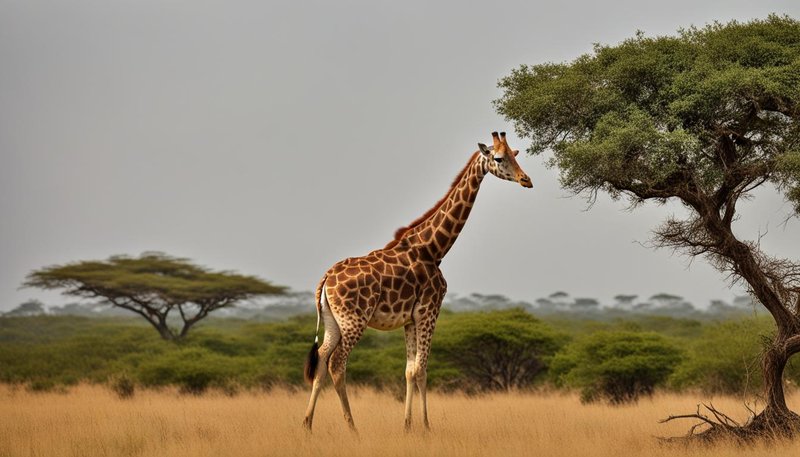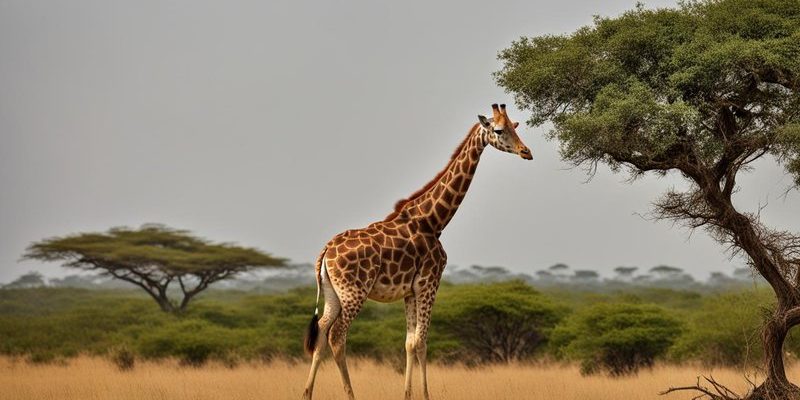
Here’s the thing: while giraffes are herbivores and don’t hunt in the traditional sense, their strategies for finding food are fascinating and essential for their survival. In this article, we’ll dive deep into the diet and hunting strategies of giraffes, exploring how they eat, what they eat, and some clever adaptations they have developed over time.
Understanding Giraffe Diets
Giraffes primarily feast on the leaves, fruits, and flowers of trees and shrubs. This diet may sound simple, but it’s actually quite selective. Giraffes have a keen sense of taste and prefer the tender leaves from certain trees, particularly the acacia. These trees not only provide nourishment but also contain compounds that may help with digestion. What’s even more interesting is that giraffes have developed a special way of feeding that allows them to strip leaves from branches without damaging the tree itself.
You might be wondering how a giraffe copes with the harsh environments of Africa. Their diet changes with the seasons. During the dry season, when food is scarce, giraffes may be seen reaching higher into the tree canopies, using their long tongues—about 18 inches!—to grasp leaves and pull them down. Their tongues are not only long but also tough and prehensile, allowing them to navigate thorns and select their favorite leaves.
Giraffes don’t drink water daily. Instead, they get a significant portion of their moisture from the foliage they consume. This unique adaptation means they can go days without drinking, thriving in some of the most arid parts of Africa. It’s like they’ve mastered the art of foraging and hydration all in one go!
Giraffes and Their Browsing Techniques
Unlike predators that chase down their meals, giraffes “browse” for food. This term might make you think of leisurely snacking, and in a way, that’s exactly right. They are slow-paced feeders, spending a significant part of their day—up to 20 hours—grazing on leaves from trees. Giraffes are herbivores, which means their body is designed to extract nutrients from plant-based foods.
One fascinating strategy giraffes employ is their “head-bobbing” technique. When they eat, they often move their heads in a rhythmic motion, which helps them reach leaves while also giving them a good view of their surroundings for any potential predators. It’s a balancing act that combines food gathering with staying alert, much like a dancer performing a delicate routine.
Additionally, giraffes tend to take advantage of their height, which gives them a significant advantage over many other herbivores. By feeding high up in trees, they can avoid competition with animals that can’t reach those leafy snacks. It’s like having a VIP pass to the best dining options in the savanna!
The Role of Giraffe Tongues
Now let’s talk about those incredible tongues. A giraffe’s tongue is not just long; it’s also dark blue-black and covered in a tough texture. This unique coloration serves a purpose—it helps protect the tongue from sunburn as they spend hours reaching for high leaves under the hot African sun. Imagine your tongue being a built-in sunscreen every time you go out to eat!
The prehensile nature of the tongue allows giraffes to grasp leaves with precision. They can wrap their tongues around a branch and strip it clean, all while avoiding sharp thorns. This ability is key to their survival, as certain trees are covered in thorns as a defense mechanism against herbivores. Giraffes have adapted superbly, turning what seems like a challenge into an effortless snack!
Moreover, their long tongues come into play when they face tough eaters. During times of food competition, giraffes can often eat leaves that other animals simply cannot access, giving them a survival edge. It’s a clear example of how evolution has fine-tuned their bodies for a specific role in the ecosystem.
How Giraffes Obtain Water
Despite living in arid climates, giraffes are brilliant at managing their hydration. While they do drink water when it’s available, they mainly get their moisture from the food they eat. Imagine munching on a juicy watermelon during a hot summer day—it’s refreshing and hydrating. That’s how giraffe diets work.
However, they do need to drink occasionally, especially during the hot months. When they do drink, giraffes must adopt a rather vulnerable position. They need to spread their legs wide to reach the ground—a tricky move for such a tall animal! This awkward stance makes them more susceptible to predators, so they are always cautious when drinking.
Moreover, giraffes often stay in areas near water sources for a reason. This not only ensures they’re close to water when needed but also provides them with multiple food options. It’s all about strategic planning in the wild!
Giraffe Behavior and Eating Patterns
Giraffes are social creatures, often found in small groups, though they don’t form tight-knit family units like some other animals. These loose herds allow them to keep an eye on each other while feeding and provide safety in numbers. Interestingly, social dynamics can influence their feeding patterns; sometimes, the presence of more giraffes can lead to different feeding strategies.
One common behavior you might notice is “necking,” a term that describes male giraffes engaging in combat by swinging their long necks to establish dominance. This behavior isn’t just for show; it can affect access to better feeding spots. The stronger males often win these contests, securing prime territory and ensuring they have first dibs on the tastiest leaves.
Giraffes also take turns watching for predators while others eat, showcasing a behavior that reflects their adaptability and intelligence. It’s almost like a synchronized dance—one giraffe keeps watch while the others snack away. This teamwork adds an extra layer of security to their feeding habits.
So, there you have it—the diet and hunting strategies of giraffes, or rather, their browsing habits! These gentle giants have unique adaptations that allow them to thrive in environments that might prove challenging for other animals. From their impressive tongues to their social feeding behaviors, giraffes have become masters at using their height and surroundings to their advantage.
Next time you spot a giraffe, remember how their diet goes beyond just munching leaves. It’s a well-orchestrated strategy that showcases their intelligence, adaptability, and the beauty of nature. Giraffes remind us that sometimes, the best approach to life is to take it slow, enjoy the view, and always be on the lookout for the next good meal.

